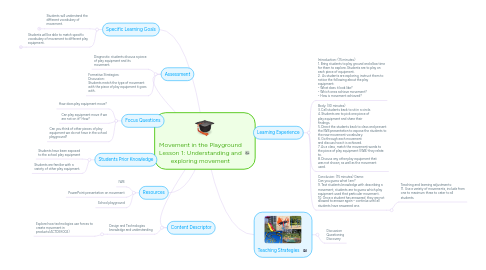Movement in the Playground Lesson 1: Understanding and exploring movement
by Melissa Trajkoski


1. Specific Learning Goals
1.1. Students will understand the different vocabulary of movement.
1.1.1. Prerequisites
1.2. Students will be able to match specific vocabulary of movement to different play equipment.
1.2.1. Task
1.2.2. Prerequisites
2. Focus Questions
2.1. How does play equipment move?
2.2. Can play equipment move if we are not on it? How?
2.3. Can you think of other pieces of play equipment we do not have in the school playground?
3. Students Prior Knowledge
3.1. Students have been exposed to the school play equipment
3.2. Students are familiar with a variety of other play equipment.
4. Resources
4.1. IWB
4.2. PowerPoint presentation on movement
4.3. School playground
5. Content Descriptor
5.1. Design and Technologies knowledge and understanding
5.1.1. Explore how technologies use forces to create movement in products(ACTDEK002)
6. Assessment
6.1. Diagnostic: students discuss a piece of play equipment and its movement.
6.2. Formative Strategies: Discussion: Students match the type of movement with the piece of play equipment it goes with.
7. Teaching Strategies
7.1. Discussion Questioning Discovery
8. Learning Experience
8.1. Introduction: (15 minutes) 1. Bring students to play ground and allow time for them to explore. Students are to play on each piece of equipment. 2. As students are exploring, instruct them to notice the following about the play equipment: • What does it look like? • Which ones achieve movement? • How is movement achieved?
8.2. Body: (30 minutes) 3. Call students back to sit in a circle. 4. Students are to pick one piece of play equipment and share their findings. 5. Direct the students back to class and present the IWB presentation to expose the students to the new movement vocabulary. 6. Go through each movement and discuss how it is achieved. 7. As a class, match the movement words to the piece of play equipment (IWB) they relate to. 8. Discuss any other play equipment that was not shown, as well as the movement used.
8.3. Conclusion: (15 minutes) Game: Can you guess what I am? 9. Test students knowledge with describing a movement, students are to guess which play equipment used that particular movement. 10. Once a student has answered, they are not allowed to answer again – continue until all students have answered one.
8.3.1. Teaching and learning adjustments: 11. Use a variety of movements, include from one to maximum three to cater to all students.
